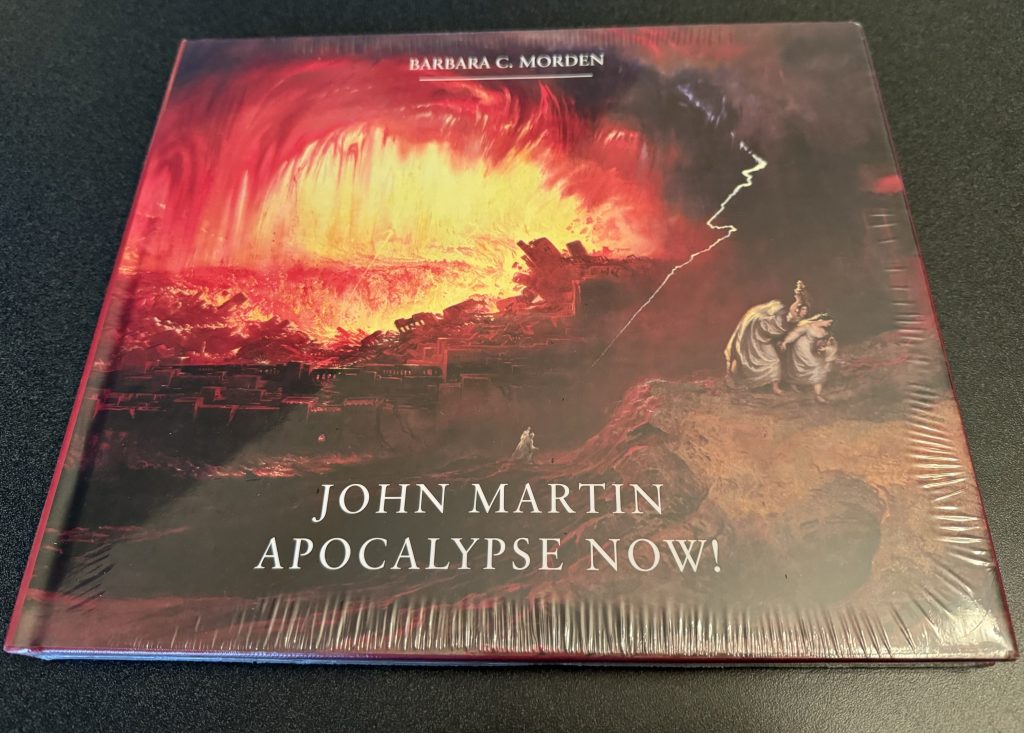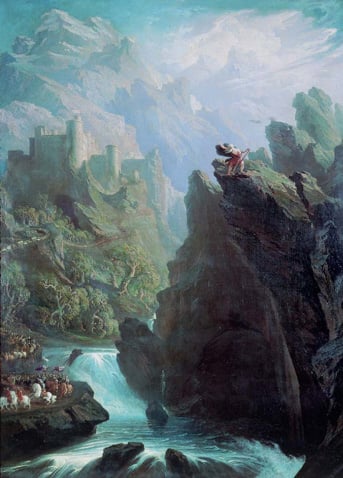My book budget has been pretty lean this year, but a book I ordered after Dad’s Celebration of Life arrived today. It features the work of artist John Martin, whose art has featured previously on this blog. Martin’s apocalyptic landscape pieces have spoken to my mood as of late, as I wander the ashy wasteland of my own devastated life. I recently read that Martin had his own share of personal tragedy – in fact, he lost his father, mother, grandmother and young son in a single year. His painting of apocalyptic scenes of death and destruction continued after a period of mourning.

I had to chuckle as I unpacked the book from the package and the title really sunk in for the first time. Immediately I was taken back to Grade 11 at Strathcona Composite High School. I was fortunate to attend classes there, enjoying Dad’s company to and from school, as he worked there as an English teacher. He had orchestrated my taking an academic challenge English course that year. It was there we delved into motifs of dark and evil, goodness and light, and tracked the Renaissance-Enlightenment-Romantic periods through literature.
My world blew up when encountering some of the many romantic poets who spoke to my soul. Shelley, Wordsworth, Keats… I remember reading reading the romantic poem in front of the class – Percy Bysshe Shelley’s “To a Skylark” – while transcendent Mozart music played on a tape recorder behind. “Hail to thee, blithe spirit”… Pure bliss. My heart found its home, and I longed to reside in the passionate Romantic era forever.
The class took a deliciously dark turn, and we began exploring themes focused on the loss of innocence and evil, which spoke to my teenaged angsty desires. At one particularly dark moment, our teacher led the class to the shadows of the basement boiler room to read TS Eliot’s The Hollow Men and The Wasteland.
I was introduced to the movie A Room With A View. An early scene tracks a prim and proper, innocent and sheltered Lucy Honeychurch observing a suddenly violent and gory scene – a man’s stabbing and the frantic aftermath as villagers attempt unsuccessfully (and rather bloody) to revive his corpse in a fountain. Although not entirely sure why, I excused myself from the classroom and began walking to the washroom along the green-tiled corridor. Darkness on the periphery of my vision began spreading inward, until dark spots began appearing in the center of my view. I’d never passed out before, but that day I nearly lost consciousness. An instinctual reaction of horror. Previously sheltered from gore and violence, my personal experience witnessing that opening scene was every bit my loss of innocence as it was Lucy’s.
Midway through the term I found myself unexpectedly led into the deepest, darkest, most labyrinthine jungles of Africa with Charles Marlow in the novella Heart of Darkness by Joseph Conrad. Kurtz’s summative quote “the horror! the horror!” has haunted me through my years, continuing to resonate to this day (and on retrospect, it sums up July 2024 nicely, actually). Studying Heart of Darkness was a natural segue to Francis Ford Coppola’s Apocalypse Now, a movie loosely tracking the same plot. My delicate sensitivities were not able to watch the movie in its entirety, but I did remain in the classroom for its duration, turning away during the more difficult visual parts. (As an adult I remain acutely distressed at gory visuals, and have to choose my viewings carefully.)
After the classroom viewing, Dad introduced me to Eleanor Coppola’s: “Hearts of Darkness: A Filmmaker’s Apocalpyse”, a documentary chronicling the production problems and bad luck cloud that seemed to hover over filming Apocalypse Now. We enjoyed the dark humour of Ford’s filming experience, and would later joke about Francis Ford Coppola, and my dark angsty grade 11 year. The humour levelled up when when the Francis Ford Coppola winery brand was established in 2010. Dad would often delight in seeking out the Coppola wine, and it graced many a dinner table during family get togethers. A private, shared, dark humour. I still have the last Coppola wine he gifted me back around May – long since emptied, naturally – and deeply cherished.
Grade 11 was a pivotal, transitional year in many ways. Beautiful worlds of possibilities opened up as as I encountered the romantic poets (John Keats: O! for a life of sensations than of thoughts!) and composers, Shakespeare’s Macbeth, and artistic films such as Room With A View and Psycho (yes.) in the class Dad had facilitated.
And outside of class – in between blissful lunchhours escapes to Hawrelak and Emily Murphy parks – we had so many other treasured shared experiences. Dad and I would listen to Paul Simon’s Rhythm of the Saints, Johnny Clegg’s Cruel, Crazy, Beautiful World and Sting’s Soul Cages album as we rode to and from Strathcona in his little blue Toyota Corolla. We watched – no, experienced – Dad Field of Dreams, Dead Poets Society, and Kenneth Branagh’s Henry V in the theatre together. Dad introduced me to The Power of Myth, an exploration of mythology with Joseph Campbell hosted by Bill Moyers. “Follow your bliss” became my life mantra. There were so many transformative artistic works forever etched in my romantic yearning soul.
Grade 11 was also the year I encountered my first John Martin painting, titled “The Bard” (below) – considerably less apocalyptic than the paintings in the book that arrived on my doorstep today, but still fraught with great tension. At the time I instinctively loved it and intuitively identified with it. Looking back now, I think the painting spoke to the awakening and transformation of my own romantic soul that year, largely due to Dad’s myriad of influences. It was a year I began to take my own path separate from conventional society, as I began to understand my own individual identity and realize self autonomy and the deeper passions that lay within my heart.

